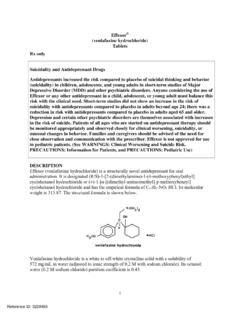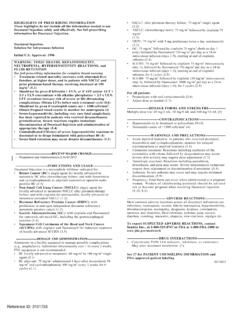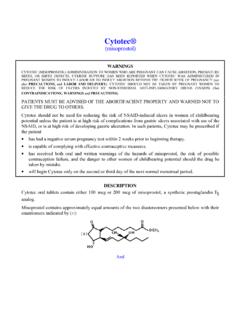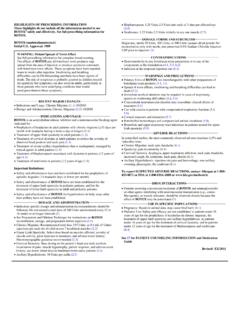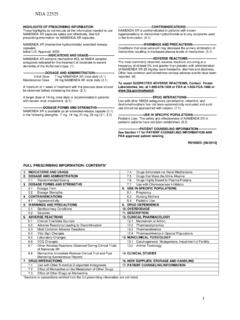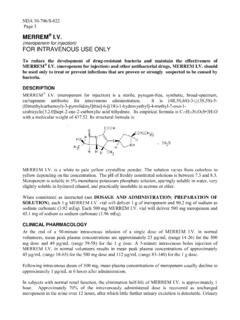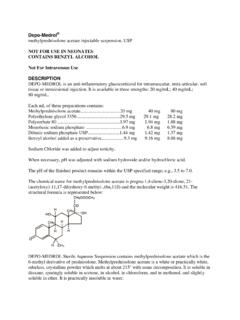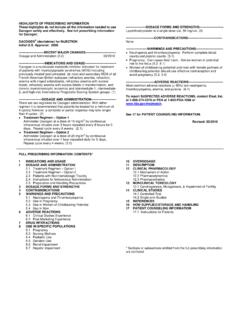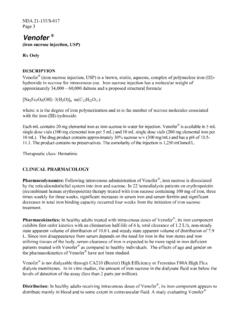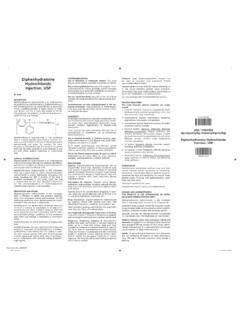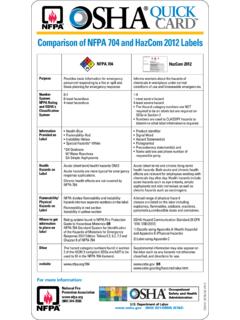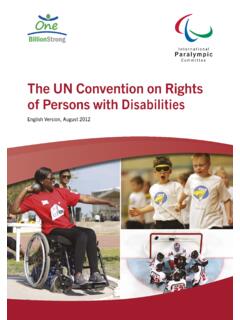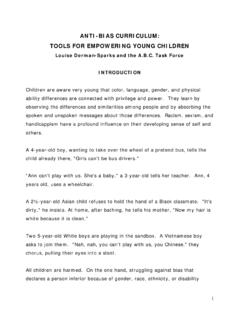Transcription of Reference ID: 3183415
1 HIGHLIGHTS OF PRESCRIBING INFORMATION These highlights do not include all the information needed to use XTANDI safely and effectively. See full prescribing information for XTANDI. XTANDI (enzalutamide) capsules for oral use Initial Approval: 2012 ---------------------------INDICATIONS AND USAGE--------------------------- XTANDI is an androgen receptor inhibitor indicated for the treatment of patients with metastatic castration-resistant prostate cancer who have previously received docetaxel. (1) -----------------------DOSAGE AND ADMINISTRATION---------------------- XTANDI 160 mg (four 40 mg capsules) administered orally once daily. Swallow capsules whole. XTANDI can be taken with or without food. ( ) ---------------------DOSAGE FORMS AND STRENGTHS--------------------- Capsule 40 mg (3) --------------------------CONTRAINDICATI ONS------------------------------- Pregnancy (4, ) -------------------------WARNINGS AND PRECAUTIONS--------------------- Seizure occurred in of patients receiving XTANDI.
2 There is no clinical trial experience with XTANDI in patients who have had a seizure, in patients with predisposing factors for seizure, or in patients using concomitant medications that may lower the seizure threshold. ( ) ------------------------------ADVERSE REACTIONS------------------------------ The most common adverse reactions ( 5%) are asthenia/fatigue, back pain, diarrhea, arthralgia, hot flush, peripheral edema, musculoskeletal pain, headache, upper respiratory infection, muscular weakness, dizziness, insomnia, lower respiratory infection, spinal cord compression and cauda equina syndrome, hematuria, paresthesia, anxiety, and hypertension. ( ) To report SUSPECTED ADVERSE REACTIONS, contact Astellas Pharma US, Inc. at 1-800-727-7003 or FDA at 1-800-FDA-1088 or -----------------------------DRUG INTERACTIONS---------------------------- --- Avoid strong CYP2C8 inhibitors, as they can increase the plasma exposure to XTANDI.
3 If co-administration is necessary, reduce the dose of XTANDI. ( , ) Avoid strong or moderate CYP3A4 or CYP2C8 inducers as they can alter the plasma exposure to XTANDI. ( , ) Avoid CYP3A4, CYP2C9 and CYP2C19 substrates with a narrow therapeutic index, as XTANDI may decrease the plasma exposures of these drugs. If XTANDI is co-administered with warfarin (CYP2C9 substrate), conduct additional INR monitoring. ( ) See 17 for PATIENT COUNSELING INFORMATION and FDA-approved patient labeling. Revised: 08/ 2012 FULL PRESCRIBING INFORMATION: CONTENTS* 1 INDICATIONS AND USAGE 2 DOSAGE AND ADMINISTRATION Dosing Information Dose Modifications 3 DOSAGE FORMS AND STRENGTHS 4 CONTRAINDICATIONS 5 WARNINGS AND PRECAUTIONS Seizure 6 ADVERSE REACTIONS Clinical Trial Experience 7 DRUG INTERACTIONS Drugs that Inhibit or Induce CYP2C8 Drugs that Inhibit or Induce CYP3A4 Effect of XTANDI on Drug Metabolizing Enzymes 8 USE IN SPECIFIC POPULATIONS Pregnancy Nursing Mothers Pediatric Use Geriatric Use Patients with Renal Impairment Patients with Hepatic Impairment 10 OVERDOSAGE 11 DESCRIPTION 12 CLINICAL PHARMACOLOGY Mechanism of Action Pharmacokinetics Cardiac Electrophysiology 13 NONCLINICAL TOXICOLOGY Carcinogenesis, Mutagenesis.
4 Impairment of Fertility 14 CLINICAL STUDIES 16 HOW SUPPLIED/STORAGE AND HANDLING 17 PATIENT COUNSELING INFORMATION *Sections or subsections omitted from the Full Prescribing Information are not listed. Reference ID: 3183415 FULL PRESCRIBING INFORMATION 1 INDICATIONS AND USAGE XTANDI is indicated for the treatment of patients with metastatic castration-resistant prostate cancer who have previously received docetaxel. 2 DOSAGE AND ADMINISTRATION Dosing Information The recommended dose of XTANDI is 160 mg (four 40 mg capsules) administered orally once daily. XTANDI can be taken with or without food [see Clinical Pharmacology ( )]. Swallow capsules whole. Do not chew, dissolve, or open the capsules. Dose Modifications If a patient experiences a Grade 3 toxicity or an intolerable side effect, withhold dosing for one week or until symptoms improve to Grade 2, then resume at the same or a reduced dose (120 mg or 80 mg), if warranted.
5 Concomitant Strong CYP2C8 Inhibitors The concomitant use of strong CYP2C8 inhibitors should be avoided if possible. If patients must be co-administered a strong CYP2C8 inhibitor, reduce the XTANDI dose to 80 mg once daily. If co-administration of the strong inhibitor is discontinued, the XTANDI dose should be returned to the dose used prior to initiation of the strong CYP2C8 inhibitor [see Drug Interactions ( ) and Clinical Pharmacology ( )]. 3 DOSAGE FORMS AND STRENGTHS XTANDI 40 mg capsules are white to off-white oblong soft gelatin capsules imprinted in black ink with MDV. 4 CONTRAINDICATIONS Pregnancy XTANDI can cause fetal harm when administered to a pregnant woman based on its mechanism of action. XTANDI is not indicated for use in women. XTANDI is contraindicated in women who are or may become pregnant. If this drug is used during pregnancy, or if the patient becomes pregnant while taking this drug, apprise the patient of the potential hazard to the fetus and the potential risk for pregnancy loss [see Use in Specific Populations ( )].
6 5 WARNINGS AND PRECAUTIONS Seizure In the randomized clinical trial, 7 of 800 ( ) patients treated with XTANDI 160 mg once daily experienced a seizure. No seizures occurred in patients treated with placebo. Seizures occurred from 31 to 603 days after initiation of XTANDI. Patients experiencing seizure were permanently discontinued from therapy and all seizures resolved. There is no clinical trial experience re-administering XTANDI to patients who experienced seizures. The safety of XTANDI in patients with predisposing factors for seizure is not known because these patients were excluded from the trial. These exclusion criteria included a history of seizure, underlying brain injury with loss of consciousness, transient ischemic attack within the past 12 months, cerebral vascular accident, brain metastases, brain arteriovenous malformation or the use of concomitant medications that may lower the seizure threshold. Because of the risk of seizure associated with XTANDI use, patients should be advised of the risk of engaging in any activity where sudden loss of consciousness could cause serious harm to themselves or others.
7 Reference ID: 3183415 6 ADVERSE REACTIONS The following is discussed in more detail in other sections of the labeling: Seizure [see Warnings and Precautions ( )] Clinical Trial Experience Because clinical trials are conducted under widely varying conditions, adverse reaction rates observed in the clinical trials of a drug cannot be directly compared to rates in the clinical trials of another drug and may not reflect the rates observed in practice. In the randomized clinical trial in patients with metastatic castration-resistant prostate cancer who had previously received docetaxel, patients received XTANDI 160 mg orally once daily (N = 800) or placebo (N = 399). The median duration of treatment was months with XTANDI and months with placebo. All patients continued androgen deprivation therapy. Patients were allowed, but not required, to take glucocorticoids.
8 During the trial, 48% of patients on the XTANDI arm and 46% of patients on the placebo arm received glucocorticoids. All adverse events and laboratory abnormalities were graded using NCI CTCAE version 4. The most common adverse drug reactions ( 5%) reported in patients receiving XTANDI in the randomized clinical trial were asthenia/fatigue, back pain, diarrhea, arthralgia, hot flush, peripheral edema, musculoskeletal pain, headache, upper respiratory infection, muscular weakness, dizziness, insomnia, lower respiratory infection, spinal cord compression and cauda equina syndrome, hematuria, paresthesia, anxiety, and hypertension. Grade 3 and higher adverse reactions were reported among 47% of XTANDI-treated patients and 53% of placebo-treated patients. Discontinuations due to adverse events were reported for 16% of XTANDI-treated patients and 18% of placebo-treated patients. The most common adverse reaction leading to treatment discontinuation was seizure, which occurred in of the XTANDI-treated patients compared to none (0%) of the placebo-treated patients.
9 Table 1 shows adverse reactions reported in the randomized clinical trial that occurred at a 2% absolute increase in frequency in the XTANDI arm compared to the placebo arm. Table 1. Adverse Reactions in the Randomized Trial XTANDI N = 800 Placebo N = 399 Grade 1-4 (%) Grade 3-4 (%) Grade 1-4 (%) Grade 3-4 (%) General Disorders Asthenic Conditionsa Peripheral Edema Musculoskeletal And Connective Tissue Disorders Back Pain Arthralgia Musculoskeletal Pain Muscular Weakness Musculoskeletal Stiffness Gastrointestinal Disorders Diarrhea Vascular Disorders Hot Flush Hypertension Nervous System Disorders Headache Dizzinessb Spinal Cord Compression and Cauda Equina Syndrome Paresthesia Mental Impairment Disordersc Reference ID.
10 3183415 XTANDI N = 800 Placebo N = 399 Grade 1-4 (%) Grade 3-4 (%) Grade 1-4 (%) Grade 3-4 (%) Hypoesthesia Infections And Infestations Upper Respiratory Tract Infectiond Lower Respiratory Tract And Lung Infectione Psychiatric Disorders Insomnia Anxiety Renal And Urinary Disorders Hematuria Pollakiuria Injury, Poisoning And Procedural Complications Fall Non-pathologic Fractures Skin And Subcutaneous Tissue Disorders Pruritus Dry Skin Respiratory Disorders Epistaxis a Includes asthenia and fatigue.
